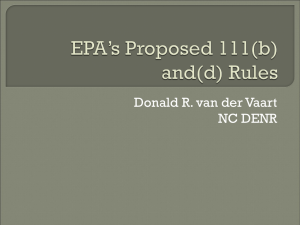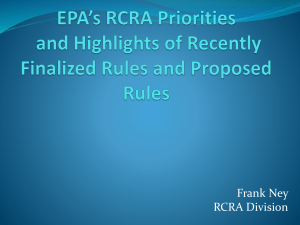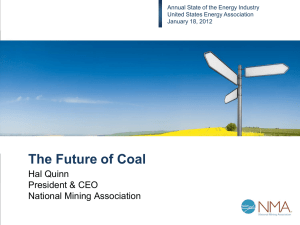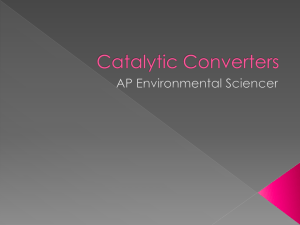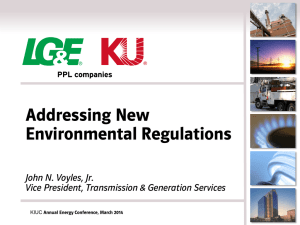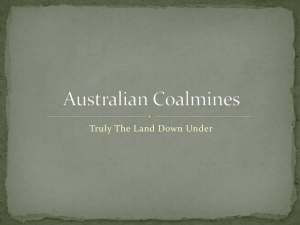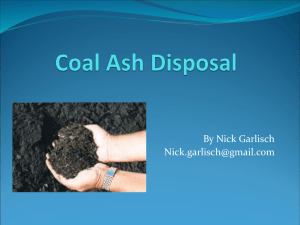Regulation as a Special Waste
advertisement
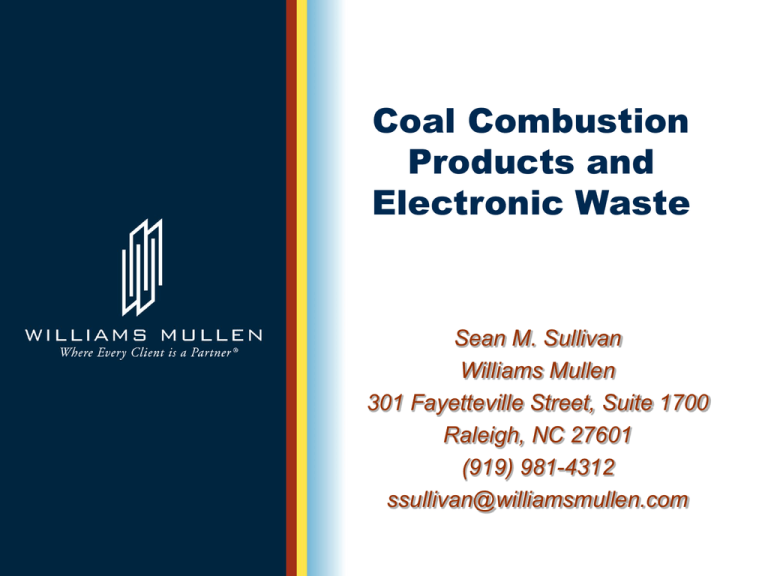
Coal Combustion Products and Electronic Waste Sean M. Sullivan Williams Mullen 301 Fayetteville Street, Suite 1700 Raleigh, NC 27601 (919) 981-4312 ssullivan@williamsmullen.com Coal Combustion Products • Four classes of byproducts resulting from burning coal. – Fly ash – Bottom ash – Boiler slag – Flue Gas Desulfurization Material Coal Combustion Products • Two Basic Handling Methods – Wet ash – ash is mixed with water and accumulated in surface impoundments. – Dry ash – ash is handled in dry form and transported for reuse or disposal. • Chemical content – Varies but typically includes: Arsenic, Barium, Cadmium, Chromium (6), Lead, Mercury, Selenium and Vanadium. Coal Combustion Products • Environmental Risks from Disposal – Groundwater contamination. – Direct human exposure. – Catastrophic failure of surface impoundments. • Alternative is beneficial reuse. – Different forms of reuse have different environmental risks. Coal Combustion Products • Current Regulatory Framework – Federal • Section 3001(b) of RCRA authorizes EPA to list certain wastes as hazardous wastes. • Section 3001(b)(3) required EPA to study coal ash before listing it as a hazardous waste. • EPA has already done two studies and twice decided not to list coal ash (1993 & 2000). Coal Combustion Products • Current Regulatory Framework – Federal • Thus, coal ash is currently regulated as solid waste, primarily by the states. • Several petitions to list it as hazardous waste are pending with EPA. – North Carolina • DWM, DWQ and Land Management all have some jurisdiction over coal ash. Coal Combustion Products • Current Regulatory Framework – North Carolina • DWM – Notification and selfimplementing requirements for disposal. • DWQ – Land application of coal ash from wastewater treatment plants. • DLM – Enforcement of dam safety rules for surface impoundments. Coal Combustion Products • EPA’s Proposal – Two options for regulating coal ash that is destined for disposal. • “Special waste” within the hazardous waste program. • Enhanced regulations for coal ash disposal sites in the solid waste rules. – Beneficial reuse – ash that will be reused will not be regulated as waste at all. Coal Combustion Products • EPA’s Proposal – Beneficial Reuse • Preamble clarifies EPA’s understanding of “beneficial reuse.” • Use of large quantities of coal ash as fill is not beneficial reuse, it is land disposal. • Similar to notion of recycling hazardous waste as a substitute for raw ingredient. – Chemical content must have benefit. Coal Combustion Products • EPA Proposal – Beneficial Reuse • Because reused materials are not wastes, reuses can continue without regulation. • Incorporation into concrete and drywall can continue. • Some reuses common in NC may be regulated as disposal. – Large scale fill, traction agent. Coal Combustion Products • EPA Proposal – Regulation as a Special Waste • Section 3004(x) allows EPA to alter general subpart C rules for coal ash, hence it is a “special waste.” • Ban on new surface impoundments. – EPA studies suggest wet ash disposal poses greater risk. – Done through a land disposal restriction on coal ash wastewaters (effective five years after rule is final). – EPA alters definition of wastewaters for coal ash to state if there is more water than ash, it is wastewater. – All solids must be removed and water must meet Universal Treatment Standards. Coal Combustion Products • EPA Proposal – Regulation as a Special Waste • Existing Surface Impoundments – Dam safety inspections. – Visual inspections every seven days. – Groundwater monitoring. – Must retrofit liners within five years. – Must close existing surface impoundments within seven years. Coal Combustion Products • EPA Proposal – Regulation as a Special Waste • Net Effect on Surface Impoundments – Existing ponds must cease operation within five years unless they have a liner. – New wastewater LDR prohibits use of all ponds after five years anyway. – So, no one will build a new one and no one will bother with retrofitting a liner on existing ones. Coal Combustion Products • EPA Proposal – Regulation as a Special Waste • New Landfills – Synthetic liners with leachate collection. – Groundwater monitoring. – TSD Permits. • Existing Landfills – Not required to retrofit liners and leachate collection. – Groundwater monitoring. – Expansion triggers new facility standards. Coal Combustion Products • EPA Proposal – Regulation as a Special Waste • Implementation – Facilities that store newly generated ash or actively manage previously stored ash must get interim status as TSD. – Ultimately must get permits. – Closure, post-closure and financial assurance will apply. Coal Combustion Products • EPA Proposal – Regulation as a Special Waste • Implementation – Every generator would likely become LQG and subject to 90 day accumulation requirements. » Storage must be in containers, tanks or containment buildings once generated. » Fees. – Transporter rules apply. Coal Combustion Products • EPA Proposal – Forced phase-out of surface impoundments. • Chosen approach is dry ash disposal in lined, permitted landfills. – LDR for dry ash becomes applicable six months after rules are final. • Dry ash must meet Universal Treatment Standards prior to land disposal. • Short time frame because EPA expects dry ash will meet standards without treatment. Coal Combustion Products • EPA Proposal – Regulation as a Special Waste • EPA expects most power plants will need to obtain interim status and permits for existing surface impoundments. • Corrective action requirements may apply at a number of sites. • Question about stigma of coal ash in beneficial use context. Coal Combustion Products • EPA Proposal – Regulation as a Solid Waste • Technical standards for landfills are similar to requirements in the Special Waste model. • Major difference is that surface impoundments are not banned. – EPA lacks authority to impose land disposal restrictions for solid waste. – Existing ponds must comply with a performance standard, retrofit a liner and leachate collection system or close within five years. – New ponds must meet standard immediately. Coal Combustion Products • EPA Proposal – Regulation as a Solid Waste • States and local governments are the primary regulatory authorities. • EPA has limited authority to regulate solid waste or to oversee state solid waste programs. • Groundwater monitoring and corrective action requirements would apply based on state rule requirements. Coal Combustion Products • EPA Proposal – Regulation as a Solid Waste • Multiple references in the preamble to EPA concerns about limited state resources, sufficiency of oversight and uniformity. • NC as an Example – DWM’s regulations allow large-scale use of coal ash as fill material with 30-day notice to state and compliance with self-implementing design criteria. No ongoing monitoring. » Sierra Club report criticizes DWM oversight. – Tougher regulations from DWQ for coal ash removed from ash ponds (regulated as treatment sludge). » Limited applicability. Coal Combustion Products • North Carolina commented in favor of the solid waste approach but asked for additional guidance regarding beneficial use. • Hard to imagine EPA promulgating rules that it cannot enforce. • EPA has asked for data about the stigma associated with the special waste approach. Coal Combustion Products • The big issue seems to be surface impoundments. – EPA believes wet ash management is far riskier than dry ash management. – The only way for EPA to ban wet ash management is through the special waste approach. • Electricity rates probably aren’t going down any time soon. Electronic Wastes • Computers, cell phones, televisions, etc. • Commonly contain – Nickel, Cadmium, Lead and Mercury. • EPA believes MSWLFs provide sufficient protection to environment, but wants to encourage recycling. • Twenty states (including NC) have e-waste recycling laws. – California regulates certain e-wastes as hazardous waste. North Carolina does not. Electronic Wastes • EPA has developed a Responsible Recycler (“R2”) certification program. – Goal is to create standard practices that minimize environmental impact of reclaiming and recycling hazardous substances from e-waste. – Helps public identify reliable vendors. Electronic Waste • North Carolina E-Waste Recycling Law – NCGS § 130A-309.130, et seq. – Ban on disposal of discarded computer equipment or televisions in solid waste landfills (effective July 1, 2011). • Only applies to materials discarded by consumers. – Residences or non-profits with fewer than 10 employees. Electronic Waste • Recycling Obligations of Manufacturers – Register with the state and pay fees. – Take responsibility for recycling of products sold in NC. – Annual report of recycling data to state. – Computer Equipment • Three types of recycling plans, which vary based on the number of collection stations the manufacturer provides. – Options include mail-ins, collection stations and collection events. – Fees vary based on type of plan. • Manufacturers can establish joint collection stations. Electronic Waste • Recycling Obligations of Manufacturers – Televisions • Must annually recycle or arrange for recycling of manufacturer’s “market share of televisions.” – Calculated based on sales data. • Manufacturers can satisfy requirements jointly. Electronic Waste • Obligations of Retailers – Ensure all computer equipment and televisions are labeled with manufacturer’s name. – Ensure manufacturer has registered with DENR. • Names of registered manufacturers posted on DENR’s website. Electronic Waste • Use of Fees Paid by Manufacturers – Paid into state Electronics Management Fund. – DENR may use all television fees and 10% of computer equipment fees to operate the program. – Remaining funds are paid to local governments for management of ewaste. Electronic Waste • Local Government Eligibility to Receive Fees – Only one governmental entity per county can receive funds – multiple governments can enter into agreements. – Amend solid waste management plan to address e-waste. – After January 1, 2013 – contract with recycler certified under EPA’s R2 program. Contact Information Sean M. Sullivan Williams Mullen 301 Fayetteville Street, Suite 1700 Raleigh, NC 27601 (919) 981-4312 ssullivan@williamsmullen.com
